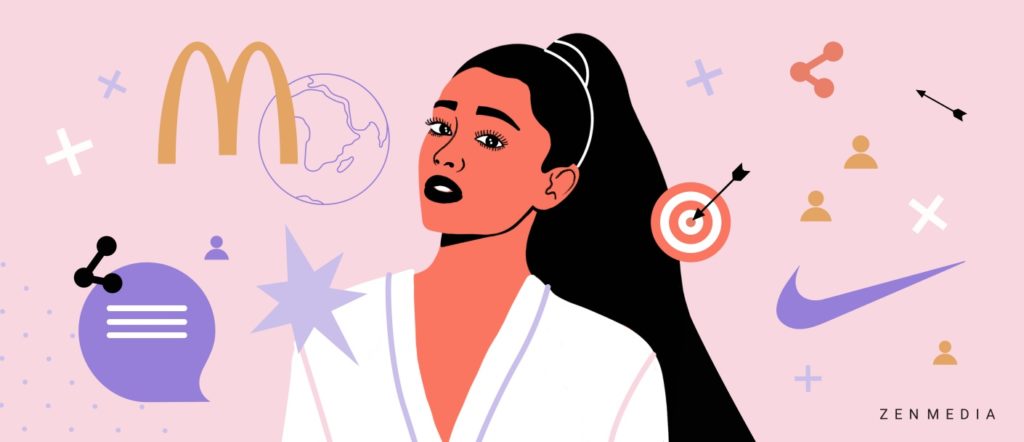What do Ariana Grande’s signature ponytail, the Geico Gecko, and the McDonald’s arches all have in common? Each could be recognized a mile away by people spanning generations, continents, and lifestyles. And that, dear reader, is brand consistency. (Did you see what we did there, Bridgerton fans?)
Ariana Grande started wearing her signature high ponytail in 2014 when her musical career was taking off. Geico began using the Gecko in 1999 after learning, through market research, that the company’s name was often mispronounced as “gecko.” A part of the original building’s design, the Golden Arches were introduced in 1953 and officially incorporated into the brand’s logo in 1962.
These icons have permeated our culture in such a way that, even without the name in front of them, a person could likely name the brand each belongs to. That kind of top-of-mind awareness allows a brand to develop frequency bias—the phenomenon where after you notice something for the first time, you are more likely to continue noticing it.
Related reading: Meaningful > Merely Measurable: Break the CTR Cycle and Bring Real Value
Frequency bias creates familiarity, and familiarity builds trust. The more we see something, the more familiar it becomes, and thus, the more credibility it has in our eyes. When a brand builds credibility, profits rise, because consumers are more likely to choose a well-known brand they find credible than a lesser-known brand.
That is why building and maintaining a strong brand identity is important. If you are constantly changing branding elements (like name, logo, colors, or even audio), consumers won’t associate your brand with any particular sentiment, and you’ll lose the ability to develop frequency bias.
During the initial B2B branding process, it’s crucial to give deep consideration to the presentation, tone, and imagery associated with your brand. Taking the time to contemplate something as simple as your brand’s colors can set your company apart from the pack—and it can save time, money, and resources by avoiding an expensive rebranding process later.
You may be thinking, “I’m not going to rebrand! I love our logo! Our colors are perfect!” But brand consistency isn’t just something to consider during the brand development stage or during a rebrand; it’s also important to consider when expanding your company into new markets. Colgate Kitchen Entrees is the perfect example of a new market launch that went terribly wrong due to brand inconsistency.
Yes, that Colgate, the toothpaste company, attempted to bring a line of frozen foods to the market in the 1960s. While there has been rumor of a Colgate beef lasagna, it’s unclear whether or not that particular meal was ever in concept at the company. But Colgate did bring a line of five items to the test market in Madison, Wisconsin, as reported by Weekly Digest from the American Institute of Food Distribution. Within a year, the items were scrapped.
So what pushed a successful hygiene brand to enter the food market? During this time, Colgate-Palmolive seemed to be facing some intense competition from Proctor & Gamble and looked to branch out into other industries. In today’s increasingly competitive market, companies are no doubt feeling pressure to differentiate themselves, but doing so in a way that is consistent with brand values, messaging, and identity is the difference between a successful expansion and, well, frozen foods that remind consumers of minty-fresh breath.
But just because the average consumer values a strong brand identity, does that mean it impacts the B2B market? Well, if differentiation is your goal, then yes. Did you know that fewer than 10% of B2B brands say that they have a consistent brand identity? The B2B buyer’s purchase journey is slightly more complex than that of the B2C buyer, which has a shorter sales cycle and fewer decision-makers in the process. So why not give your B2B buyers all the reasons to feel not only comfortable with your brand but excited about purchasing from your company. Remember that comfort comes from familiarity, and familiarity eventually leads to profitability.
But it’s not just the typical sales sheets and pitch decks that need to convey a strong, consistent brand identity to win over B2B consumers. A study on social buying from International Data Corporation showed that 75% of B2B buyers and 84% of C-level executives use social media to support their purchase decisions. So even though you may not be targeting the primary audience on Facebook, LinkedIn, or Twitter, your brand could immensely benefit by having a branded, up-to-date presence on social platforms.
Related reading: Creating an Earlier Buyer Journey: Why It Matters, and Why You Should Be Reaching Out
And don’t worry if you feel like there’s nothing engaging for your company to post. Even if you’re selling parts for factory machines, you can still create interesting B2B social media marketing content that uniquely conveys your brand messaging. For example, you could tell the stories of the employees who make the parts you sell: why they work for your company, who they are outside of work, or why their work is important to them.
You may think that B2B buyers purchasing those factory machine parts aren’t interested in the emotional stories of the employees who make them, but you’d be wrong. A survey of more than 3,000 B2B buyers found that the emotional connection we’re talking about is something they actually seek out. In fact, those potential B2B buyers that feel a “high brand connection” are 60% more likely to convert than those who don’t.
So, we’ve established that brand consistency is key—whether you are B2B or B2C. But what if your brand really does need an overhaul? If you failed to build a strong brand voice, perspective, messaging, and image from the start, you need to ensure all those components work together to convey the right brand identity when you decide to rebrand.
Sound like a lot to take on? Reach out. We can help you develop your brand to make it irresistible to consumers.




